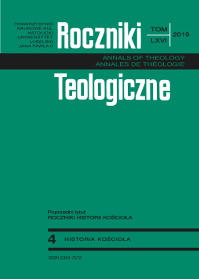Chrześcijańskie zagadnienia protologiczno-eschatologiczne wyrażone za pomocą pogańskich liter. Na podstawie centonu De Verbi Incarnatione
Abstrakt
Artykuł prezentuje kwestie protologiczno-eschatologiczne w chrześcijańskim centonie De Verbi Incarnatione. Głównym jego celem jest ukazanie w jaki sposób centonista wykorzystał słowa Wergiliusza, ażeby stworzyć chrześcijańską teologię w swoim utworze. Czy użył tylko liter? Czy wykorzystał również kontekst z Eneidy, Bukolik i Georgik? W poszukiwaniu podobieństw i różnic pomiędzy De Verbi Incarnatione i poematami Wergiliusza przeanalizowane zostały kwestie z zakresu nauki o początku i czasach ostatecznych: stworzenie i rządy nad światem, istnienie szatana, zaistnienie grzechu, jego skutki oraz eschatologia w ogólności.
Centonista w swojej pracy wykorzystuje głównie warstwę leksykalną utworów Wergiliusza, w większości przypadków nie przejmując ich kontekstu. W centonie dostrzec można pewne podobieństwa między postaciami utworu chrześcijańskiego a tymi, które występują w twórczości najważniejszego poety epoki augustowskiej.
Bibliografia
Augustini S., Epistulae, pars III, ep. 137, Al. Goldbacher, Vindobonae–Lipsiae 1904.
Cullhed S.S., Proba the Prophet. The Christian Virgilian Cento of Faltonia Betitia Proba, Leiden 2015.
Drzyżdżyk Sz., Chrystologia w perspektywie Mitu Trojańskiego, Scriptum, Kraków 2017.
Drzyżdżyk Sz., Demonologia Homerocentonów, „Bielsko-Żywieckie Studia Teologiczne” 2016, nr 17, s. 89-98.
Gilski M., Mariologia centonów, Scriptum, Kraków 2015, s. 195-208.
McGill S., Virgil Recomposed. The Mythological and Secular Centos in Antiquity, Oxford 2005, s. XV.
Migdał M., Piątek M., Chrystologia „Christus patiens”, Scriptum, Kraków 2017.
Piasecki D., Centony Homeryckie, Scriptum, Kraków 2017.
Piasecki D., Centony Homeryckie – spotkanie tradycji pogańskiej z chrześcijańską, Scriptum, Kraków 2014.
Piasecki D., Hermeneutyka Centonu Homeryckiego – studium przypadku, „Littera Antiqua” 2011, nr 2, s. 117-132.
Piasecki D., Pochodzenie nazw własnych w Centonach Homeryckich, „Littera Antiqua” 2012, nr 5, s. 101-114.
Piątek M., Miejsce, rola i wykorzystanie tragedii „Prometeusz w okowach” w chrześcijańskim centonie „Christus Patiens”, „Bielsko-Żywieckie Studia Teologiczne” 2017, nr 18, s. 195-205.
Poetae Christiani Minores, CSEL, vol. 16, pars 1, Vindobonae MDCCCLXXXVIII, s. 615-620.
Stabryła S., Wergiliusz – świat poetycki, PAN, Wrocław 1983.
Stehlikova E., Centones Christiani as a Means of Reception, „Listy filologické” 1987, nr 1, s. 13.
Trisoglio F., La struttura del „Christus patiens”, „Orpheus. Rivista di umanita classica e cristiana” 1995, nr 16, s. 330-365.
Trisoglio F., La Vergine Maria come protagonista del Christus patiens, „Marianum” 1979, nr 41, s. 199-266.
Virgile, Bucoliques, Les Belles Lettres, Paris 1992.
Virgile, Géorgiques, Les Belles Lettres, Paris 1995.
Virgile, Énéide, Les Belles Lettres, t. 1, Paris 1977.
Virgile, Énéide, Les Belles Lettres, t. 2, Paris 1993.
Virgile, Énéide, Les Belles Lettres, t. 3, Paris 1987.
Wergiliusz, Eneida, Zakład Narodowy im. Ossolińskich, Wrocław 1980.
Wojtylak-Heszen A., Tragedia późnoantyczna ΧΡΙΣΤΟΣ ΠΑΣΧΩΝ a jej klasyczne źródła, Collegium Columbinum, Kraków 2004.
Ziółkowski J.M., Putnam M.C.J., The Viriglian Tradition. The First Fifteen Hundred Years, New Haven–London 2008.
Copyright (c) 2019 Roczniki Teologiczne

Utwór dostępny jest na licencji Creative Commons Uznanie autorstwa – Użycie niekomercyjne – Bez utworów zależnych 4.0 Międzynarodowe.





